#John Kassel
Photo

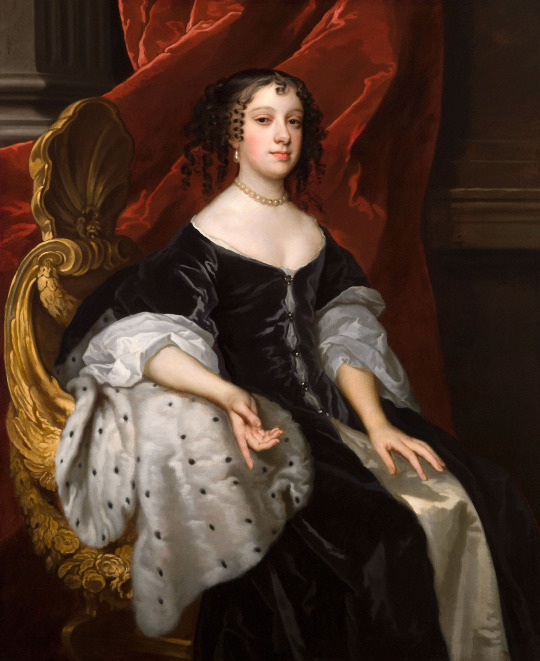
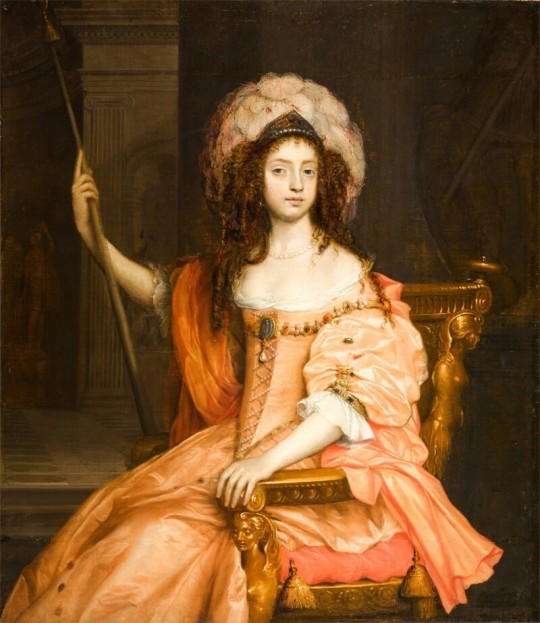



Baroque era dress -
Top 1656 Amalia von Hesse-Kassel by Adriaen Hanneman (Sotheby's 28Jan16 auction Lot26)2880X3559 @72 2.3Mj.
Second row left 1665 Catherine of Braganza, Queen consort of England, Scotland, and Ireland by Sir Peter Lely (location ?). From tumblr.com/blog/view/costumedufilm 1568X1920 @72 792kj.
Second row right Lady, possibly Catherine of Braganza by John Michael Wright (private collection). From tumblr.com/roehenstart 800X923 @72 207kj.
Third row 1660s Jacquemijna Le Pla by Abraham van den Tempel (auctioned by Sotheby's). From tumblr.com/blog/view/the-perdita 1280X1604 @72 749kj.
Fourth row left 1670 Maria Dircksdr Bogaert by Gerbrand van den Eeckhout (Kremer Collection - Amsterdam, Netherlands). From tumblr.com/shewhoworshipscarlin 1122X1300 @72 293kj.
Fourth row right 1660-1680 Noble lady with a dog by Jan de Baen (Louvre). From tumblr.com/the-perdita.
#1650s fashion#1660s fashion#1670s fashion#Baroque fashion#English restoration fashion#Louis XIV fashion#Amalia von Hesse-Kassel#Adriaen Hanneman#side curl coiffure#hair mat#off shoulder scoop neckline#puffed sleeves#V waistline#Catherine of Braganza#Peter Lely#split bodice#robes#John Michael Wright#feather headdress#tiara#laced bodice#chemise#modesty piece#Jacquemijna Le Pla#Abraham van den Tempel#Maria Dircksdr Bogaert#Gerbrand van den Eeckhout#lace bertha#Jan de Baen#sheer bertha
19 notes
·
View notes
Text
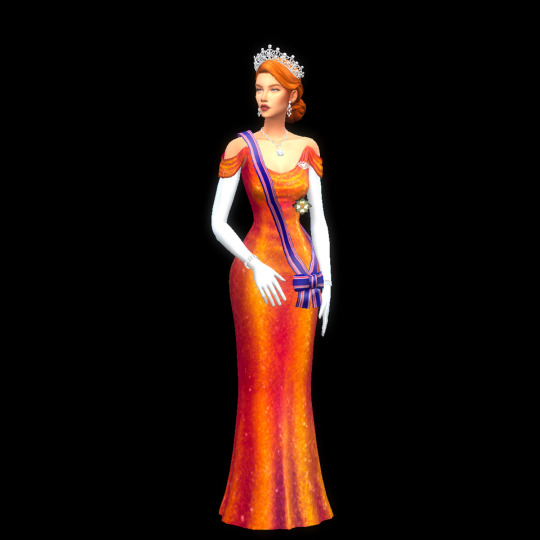

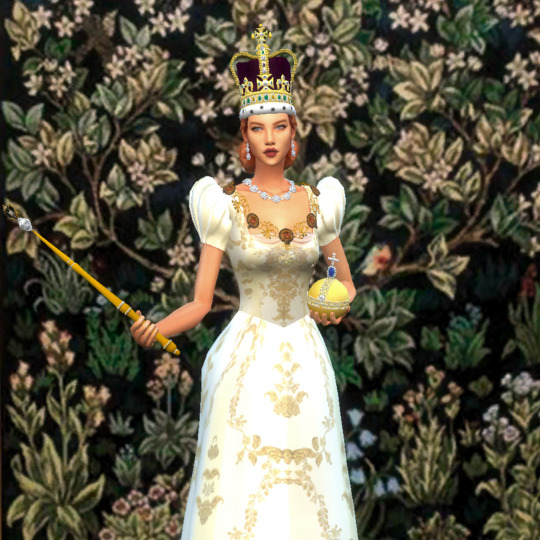



Anastasia (Anastasia Caroline Louise Marie; Born 13 February 1980) is Queen of the Kingdom of Corrilea and the Corrilean Dominions, having ascended the throne following her mother’s abdication in 2010.
Anastasia was born at St Mary’s Children’s Hospital, as the first child of the then Crown Princess Catherine and Prince William, being born 15 minutes before her twin brother, Prince Edward. In 1989 at the age of nine, Anastasia become heir apparent to the throne upon the abdication of her grandfather and subsequent accession of her mother. The young princess was educated at home until the age of 12 by tutors under the supervision of her grandmother, Elizabeth of Schleswig-Wolfenbüttel-Kassel. Afterwards she went to Easton Creek Academy, before attending King’s College.
In 1999, she married Alexander Snow in a public ceremony at the Cathedral of St John the Holy. A year later, the couple had a set of twins, Princess Isabella and Prince Theodore. In 2006, the couple announced their divorce amidst domestic abuse rumours against Alexander. Following the divorce, the then Crown Princess filed for sole custody of the children and won six months later, after the Supreme Council Judge Mark Ferguson ruled in her favour.
As Crown Princess Anastasia held thousands of patronages and was widely celebrated in by the media. In 2007, she meet her second partner Lady Beverly Coture. The pair dated for several years, before tying the knot in 2009, in a private ceremony at the Royce.
On the 15 April 2010, she ascended the throne after her mother, Catherine I abdicated due to health concerns. She is the 31st monarch of Corrilea and the fourth female sovereign.
#theroyalsofcorrilea#ts4 royalty#ts4 royal family#sims 4 royalty#the sims 4#ts4 royal story#sims 4#sims 4 royal family#sims 4 royal simblr#sims 4 royal legacy#sims royal family
27 notes
·
View notes
Photo

Jacques de l'Ange - Gluttony - 1642
oil on canvas, height: 125.1 cm (49.2 in); width: 102.2 cm (40.2 in)
Milwaukee Art Museum, Milwaukee, Wisconsin, United States of America
Jacques de l'Ange or the Monogrammist JAD ([c. 1621 – 1650) was a Flemish painter and draughtsman known for his genre scenes and history paintings executed in a Caravaggesque style. The artist was only rediscovered in the mid-1990s as his work was previously attributed to other Northern Caravaggists and in particular those of the Utrecht School.
Jacques de l'Ange is mainly known for his series of seven genre paintings depicting the Seven deadly sins.
The seven deadly sins, also known as the capital vices or cardinal sins, is a grouping and classification of vices within Christian teachings. Although they are not directly mentioned in the Bible, there are parallels with the seven things God is said to hate in the Book of Proverbs. Behaviours or habits are classified under this category if they directly give rise to other immoralities. According to the standard list, they are pride, greed, wrath, envy, lust, gluttony and sloth, which are contrary to the seven capital virtues.
This classification originated with the Desert Fathers, especially Evagrius Ponticus. Evagrius' pupil John Cassian with his book The Institutes brought the classification to Europe, where it became fundamental to Catholic confessional practices as documented in penitential manuals, sermons such as "The Parson's Tale" from Chaucer's Canterbury Tales and artworks such as Dante's Purgatory where the penitents of Mount Purgatory are grouped and penanced according to their worst sin. Church teaching especially focused on pride, which was thought to be the root of all sin since it turns the soul away from God; and also on greed or covetousness. Both of these were to undercut other sins.
The seven deadly sins are discussed in treatises and depicted in paintings and sculpture decorations on Catholic churches as well as older textbooks. The seven deadly sins, along with the sins against the Holy Ghost and the sins that cry to Heaven for vengeance, are taught especially in Western Christian traditions as things to be deplored.
He executed various copies of the series attesting to the popularity of the subject at the time. They are kept, amongst others, in the Hermitage Museum, the Milwaukee Art Museum, the Museumslandschaft Hessen Kassel and the Musée du Séminaire (Quebec). On its website, the Hermitage still attributes the Allegory of Vanity to Joachim Sandrart. Another painting in the series of deadly sins depicting 'Lust' has been identified in the collection of the Reggio Emilia, Galleria Parmiggiani, where it had been attributed to Joachim Sandrart and Matthias Stom.
The Ashmolean Museum has a complete set of the seven compositions executed on copper. Some of these are believed to have been painted by Jacques de l'Ange as small-scale ricordi after completion of the series around 1642 and others may be designs for the larger paintings. It is not clear whether all large paintings in the series were completed.
Like other followers of Caravaggio, de l’Ange used light, usually from a single source, to create dramatic effect. For instance in his composition representing Gluttony he placed a candle on the right-hand side of the composition to create dramatic, almost theater-like shadows. As a result, the scene emerges from the dark background and gains depth as the modelling of the figures is accentuated.
60 notes
·
View notes
Text
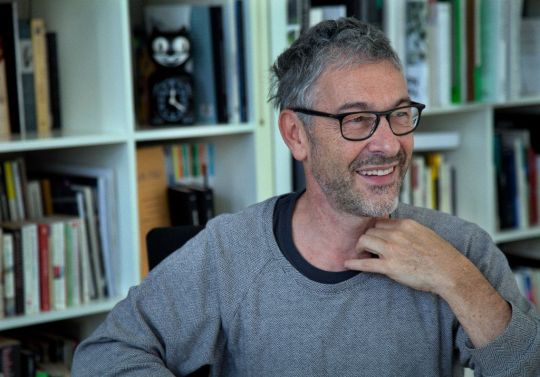
“I’m more interested in looking
for something transitory than
in producing a conclusion.”
Pierre Huyghe
“I’m interested in contingency,” the French artist Pierre Huyghe has said. “Of what is not predictable. Of what is unknown. I think that has somehow been a core of my work.”1 Pursuing interests in contingency and unpredictability, Huyghe creates art forms that incorporate living organisms, such as dogs, turtles, spiders, peacocks, ants, and bees. Over the course of an exhibition, his living works of art grow, decay, and die. Huyghe said, “They are not made for us. They are not made to be looked at. They exist in themselves.”2
Throughout his career, Huyghe has experimented with many mediums and technologies, including film, sculpture, photography, music, and living ecosystems. At the outset of his career, Huyghe collaborated with artists whose work explored human relations and their social context; to describe their interests, the curator and art critic Nicolas Bourriaud coined the term Relational Aesthetics. In the late 1990s and early 2000s, Huyghe’s works often reenacted notable artworks or popular footage from mass media. In Silence Score (English Version), a musical notation of John Cage’s pivotal composition 4'33", he created a readable score for the silent piece using a computer algorithm.
In 1997, with artists Charles de Meaux, Philippe Parreno, and Dominique Gonzalez-Foerster and curators Xavier Douroux and Franck Gautherot, Huyghe cofounded a film production company called Anna Sanders Films. They named the company after a fictional character first developed in a magazine released in 1997. Blanche-Neige Lucie, the company’s first film, stars Lucie Doléne, the voice actor who dubbed the Disney character Snow White in French, and who won a lawsuit against the Walt Disney Corporation for the rights to the reproduction of her voice. The film features Doléne humming the melody of “Someday My Prince Will Come” in an empty film studio, facing the camera, while her story is told through the subtitles. The work explores how a voice can be used to create a character, and who then owns that product.
The Host and The Cloud fuses scripted action and improvised narratives generated by the actors. The yearlong project records theatrical events that took place in an abandoned museum in Paris on three holidays: the Day of the Dead, Valentine’s Day, and May Day. In a variety of fictional settings, 15 actors clad in LED masks perform alongside puppets and animation. These spontaneous elements reflect Huyghe’s interest in contingency and adding dynamic layers to his storylines.
Originally created for Documenta 13 in 2012, Huyghe’s Untilled (Liegender Frauenakt) is a reclining female nude whose head is covered by a live beehive. The work was part of an entire ecological system the artist created in a composting area in Karlsaue Park in Kassel, Germany. In a video Huyghe filmed during the exhibition, his camera captured a wide range of beings at different scales, including minute species that are barely visible to the naked eye. Huyghe aims to “intensify the presence of things, to find its own particular presentation, its own appearance and its own life, rather than subjecting it to pre-established models.”3 With interest in “the transitory state, in the in-between,” his complex worlds blur the boundaries between the natural and the artificial, the physical and the virtual, and the real and the fictional.4 In 2015 and again in 2023, the statue found itself in MoMA’s Sculpture Garden, placed in a new context and in conversation with other works of art. During the summer, the bees travel in and out of the garden to pollinate and build their hive.
Huyghe’s artistic practice reflects his belief that life is in constant flux, and that all beings exist beyond the perceivable realm of human senses and knowledge. By engaging with unconventional materials and technologies, he provides us with a way to see, feel, and experience the wild, untilled world we are living in.
Source: MoMA / Pic: YBCA
6 notes
·
View notes
Text
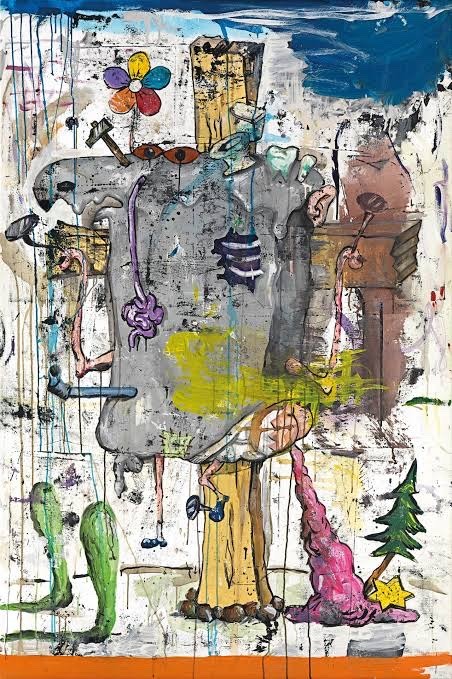
1. A painting for a proposed sculpture
2.
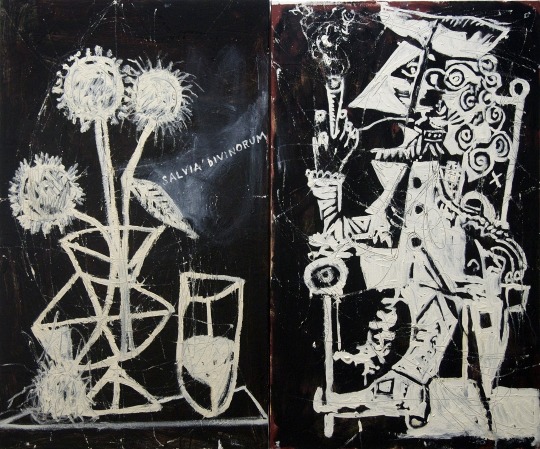
1. A Painting for a Proposed Sculpture
2. ILLUSTRATOR
Manuel Ocampo is an artist whose work, both stylistically and thematically, has inspired my process as of late.
Best known for his Catholic Grand Guignol imagery, Ocampo once claimed to have learned his signature faux retablo style from a priest for counterfeiting purposes. Largely self-taught, he dazzled the art world with his precocity and virtuosity, leaping from a single one man show in Los Angeles in 1988 to rave reviews and participation at the Documenta and Venice and Whitney Biennials. Among his provocative subjects are ancient forms of crosses, including the swastika, a symbol that caused his expulsion from the main floor and relegation to the basement at Documenta IX in Kassel, Germany in 1992.
Ocampo’s surreal imagery begs explanation; he layers Spanish religious icons, American pop culture, local kitsch and obscure texts to illustrate Filipino post-colonial identity.
On his compositional style: “This is where I live. It’s a mess, which is why my paintings are a mess,” he claimed, starting the slide show with an aerial view of a massive Manila traffic jam, vehicles and people gridlocked in anarchy.
On his provocative subject matter: “I’m not afraid of controversy—in fact, I invite it,” he admitted, in response to a question on his intentions. “I’m saying, look at this, but don’t look at it, it’s just a painting, it is not real” —reminding the audience that his paintings are mere two-dimensional explorations, and no gods were actually harmed in the making of his art.
On his choice of medium. “I’ve always been a painter, it’s always been about how I can push painting further. I might ask people to pay attention to the pieces in ways other than conventional painting, but in the end I’m expanding the concept of what a painting is.” Ocampo was referring to his forays into installation, such as at a Los Angeles show where he stripped his paintings from their frames and laid them on the floor to be walked on, hanging one as a hammock.
On sources of inspiration. He credits his first job drawing editorial cartoons for his mother’s newsletter with his love of incorporating text in his works. He finds material literally everywhere. A postcard with the cryptic text, “comprehensive only to a few initiates,” found on the floor, was appropriated in full for a text-only painting (2000-2001). Another text that sparked a work was conceptualist John Baldessari’s quote, “Everything is purged from this painting but art, no ideas have entered this work,” which he inscribed around a Duchampian toilet, overturned and spilling intestines, in his work, Artist Examining Life Closely (1998). The work currently on exhibit, An Object at the Limits of Language—Necromantic Kippian Emancipator: No. 2 was painted in response to the death of German artist Martin Kippenberger, whose absurdist humour Ocampo greatly admires.
3 notes
·
View notes
Text




Caravan (Owl Painting), 84 in. x 84 in., Oil on canvas. 2012. National Museum of Wildlife Art Permanent Collection (Jackson, WY). Purchased with funds generously donated by Adrienne & John Mars.
Artwork & images ©Peter D. Gerakaris. All Rights Reserved.
TRAVELING EXHIBIT: UN/NATURAL SELECTIONS: WILDLIFE IN CONTEMPORARY ART
Installation Views & Museum Preview at The Huson River Museum (Yonkers, NY)
OCTOBER 13, 2023 – JANUARY 14, 2024
From Julie Buffalohead and Kiki Smith to Walton Ford and James Prosek, the artists in this exhibition represent another stage in the evolution of animal art.
Wild animals have been present in art since the first artists painted images on cave walls or carved figures in stone tens of thousands of years ago. Today’s artists continue to use animal imagery as away to address humanity’s interconnectedness with the natural world.
Un/Natural Selections: Wildlife in Contemporary Art, organized by the National Museum of Wildlife Art, explores the meaning of these creative expressions within the context of contemporary art. Featuring a diverse group of more than forty artworks from the National Museum of Wildlife Art’s permanent collection, the exhibition offers a wide range of styles in a variety of media, divided into four thematic sections: Tradition, Politics,Science, and Aesthetics. These realms act as overlapping chapters, investigating the ways we use animal imagery to tackle human concerns and responsibilities.
The title of this exhibition is a play on Charles Darwin’s concept of natural selection from his pivotal writing, On the Origin of Species (1859). Darwin’s ideas contributed much to the development of wildlife art in the late nineteenth century, as artists began to represent animals in natural habitats, enacting natural behaviors. From Julie Buffalohead and Kiki Smith to Walton Ford and James Prosek, the artists in this exhibition represent another stage in the evolution of animal art: choosing to represent animals in alternative, unnatural spaces—spaces more often directly linked to civilization than to wilderness.
LEARN MORE
FEATURED ARTISTS
Troy Abbott • Timothy Berg and Rebekah Myers • George Boorujy • John Buck • Julie Buffalohead • Mark Dion • Mark Eberhard • Dave Eggers • Juan Fontanive • Walton Ford • Scott Fraser • Peter Gerakaris • Gillie and Marc • Penelope Gottlieb • Starr Hardridge • Nicola Hicks • Dennis Hlynsky • Barbara Kassel • Zoe Keller • Wendy Klemperer • Kollabs, Anke Schofield and Luis Garcia-Nerey • Emily Lamb • Ruth Marshall • Wendy Maruyama • Robert McCauley • William Morris • Marc Petrovic • James Prosek • Shelley Reed • Preston Singletary • Allison Leigh Smith • Kiki Smith • Shawn Smith • Lauren Strohacker and Kendra Sollars • William Sweetlove • Leslie Thornton • Paul Villinski • JenMarie Zeleznak
Un/Natural Selections: Wildlife in Contemporary Art is organized by the National Museum of Wildlife Art. Generous support provided by Art Bridges.
#peter gerakaris#peter d. gerakaris#national museum of wildlife art#wildlife art#owl#barred owl#falcons#falconry#colorful#oil painting#tetons#wyoming#jackson hole#painting#museum
1 note
·
View note
Text
Based on the autobiographical novel, the tempestuous 6-year relationship between Liberace and his (much younger) lover, Scott Thorson, is recounted.
Credits: TheMovieDb.
Film Cast:
Liberace: Michael Douglas
Scott Thorson: Matt Damon
Seymour Heller: Dan Aykroyd
Bob Black: Scott Bakula
Dr. Jack Startz: Rob Lowe
Ray Arnett: Tom Papa
Mr. Felder: Paul Reiser
Carlucci: Bruce Ramsay
Mr. Y: Nicky Katt
Billy Leatherwood: Cheyenne Jackson
Tracy Schnelker: Mike O’Malley
Adoption Attorney: David Koechner
Cary James: Boyd Holbrook
Frances: Debbie Reynolds
Lou: Eric Zuckerman
Assistant Director: Eddie Jemison
Director: Randy Lowell
Stunt Actor: Tom Roach
Camera Assistant: Shamus Cooley
Sound Mixer: John Smutny
Rose Carracappa: Jane Morris
Joe Carracappa: Garrett M. Brown
George Liberace: Pat Asanti
Dora Liberace: Casey Kramer
Assistant Stage Manager: James Kulick
Make-up Artist: Paul Witten
Gladys: Deborah Lacey
Sue: Susan Caroll Todd
Backstage Flirt: Austin Stowell
Backstage Flirt: Francisco San Martin
Stagehand: Anthony Crivello
Scott’s Half-Brother, Wayne: Kiff VandenHeuvel
Dorothy: Nikea Gamby-Turner
June: Charlotte Crossley
Liberace’s Attorney: Josh Meyers
Joel Strote: Harvey J. Alperin
Dr. Ronald Daniels: Jerry Clarke
Anchorwoman: Lisa Frantz
Health Department Spokesman: Shaun T. Benjamin
Priest at Funeral: John Philip Kavcak
Young American Dancer (uncredited): Kelly Allen
Funeral Mourner (uncredited): Gregg Atwill
Patron (uncredited): Greg Baine
Guy Outside Casino (uncredited): Brian Blu
Party Guest (uncredited): Paul Borst
Angie Liberace (uncredited): Barbara Brownell
Sex Club Patron (uncredited): Lee Christian
Kazarian (uncredited): Kass Connors
Showgirl (uncredited): Jacquelyn Dowsett
Concert Fan (uncredited): Timothy Skyler Dunigan
Deposition Reporter (uncredited): Fielding Edlow
French Guy #2 (uncredited): Corey Eid
Impossible Dream Dancer (uncredited): Krystal Ellsworth
Young American Dancer (uncredited): Kelli Erdmann
Hair Stylist (uncredited): Amber Lee Ettinger
Young American (uncredited): Derek Ferguson
Adult Bookstore Patron (uncredited): Joe Filippone
Adult Bookstore Worker (uncredited): Aussie Guevara
Dancer (uncredited): Brandon Henschel
Young American Dancer (uncredited): Kara Hess
Stage Manager (uncredited): Lenny Jacobson
Mourner (uncredited): Richard Allan Jones
Valet (uncredited): Adam J. Kassel
Impossible Dream Dancer (uncredited): Dominique Kelley
Cameraman (uncredited): David Dustin Kenyon
Theatre Stage Hand (uncredited): Kirk Krogstad
Billy (uncredited): Kristin Lindquist
Showgirl (uncredited): Rachael Markarian
Patron (uncredited): Hugo Pierre Martin
Sex Club Worker (uncredited): Paul McDade
Young American Dancer (uncredited): KC Monnie
Bar Patron (uncredited): Max Napolitano
Tailor (uncredited): Gregory Niebel
Show Boy (uncredited): Cassidy Noblett
Dancer (uncredited): Ryan Novak
Young American (uncredited): Meredith Ostrowsky
Sex Couple #1 (uncredited): Lance Patrick
Liberace Showgirl (uncredited): Brittany Perry-Russell
Dancer (uncredited): Ferly Prado
On-Air News Reporter (uncredited): Mike Jerome Putnam
Maitre d’ (uncredited): Thure Riefenstein
Second Anchorwoman (uncredited): Stephanie Maura Sanchez
News Reporter (uncredited): Jimmy Scanlon
French Guy #1 (uncredited): Roby Schinasi
Reporter (uncredited): Nellie Sciutto
Bookstore Patron (uncredited): Franklin J. Sterns
Startz Surgeon (uncredited): C.J. Stussi
Showgirl (uncredited): Becca Sweitzer
Stagehand (uncredited): Trace Taylor
Stagehand (uncredited): Anna Wendt
Print Reporter (uncredited): Ryken Zane
Nightclub Patron (uncredited): Judy Bruno Bennett
Bookstore Guy (uncredited): Cal Rein
Reporter (uncredited): Brian Neil Hoff
Young American Dancer (uncredited): Nick Lanzisera
Mourner (uncredited): Charles Moniz
Showgirl (uncredited): Ayesha Orange
Young American Dancer (uncredited): Jason Williams
Self (archive footage) (uncredited): Johnny Carson
Self (archive footage) (uncredited): Peggy King
Film Crew:
Editor: Steven Soderbergh
Screenplay: Richard LaGravenese
Book: Scott Thorson
Book: Alex Thorleifson
Producer: Susan Ekins
Fir...
#based on memoir or autobiography#based on novel or book#based on true story#celebrity#gay theme#in the closet#las vegas#Top Rated Movies
0 notes
Text
Norwich University Watercolor Painting
Artist Alicia J. Stonebreaker, Polish born and trained at the Academy of Fine Arts, Poznan, Poland and the Kassel Art Academy in Germany, sketched this momentous scene of the 1974 Norwich University graduation ceremonies. Alicia was sitting in the crowd with her husband, Vermont District Court Judge John P. Connarn (Norwich '41).
0 notes
Text
Artist-run collectives and self-organized initiatives
youtube
Taring Padi
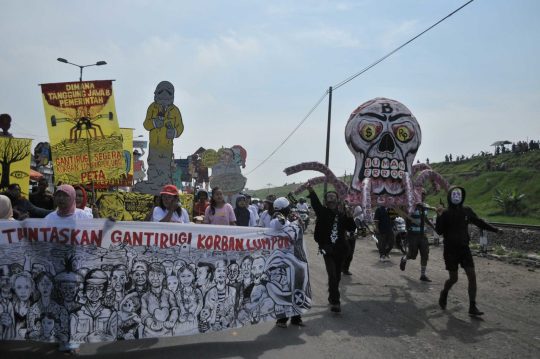
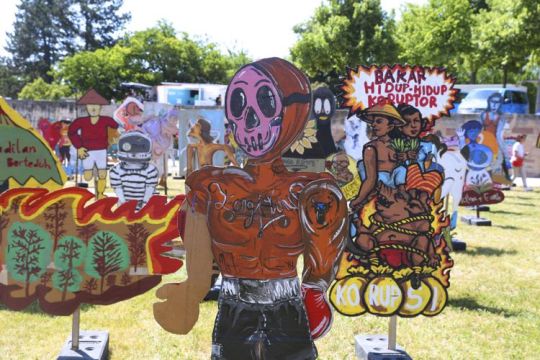
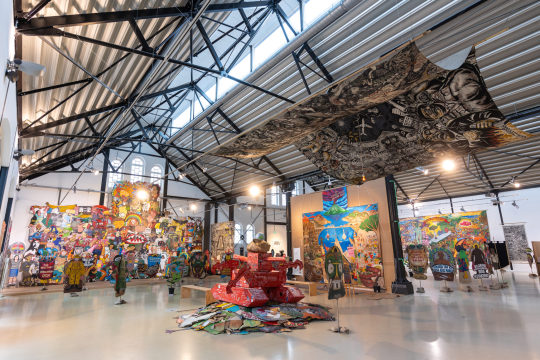
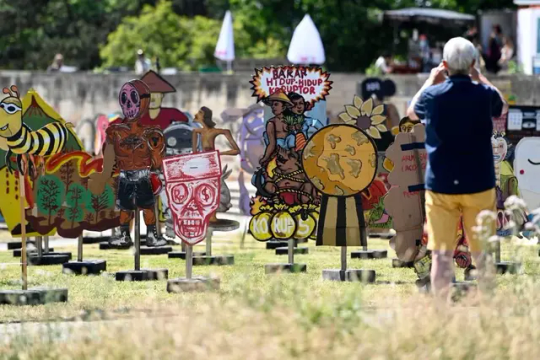
The Institute of People Oriented Culture Taring Padi was founded in 1998 by a group of progressive art students and activists in response to the Indonesian socio-political upheavals during the country’s reformation era. As such, Taring Padi’s artistic practice is always part of and contextualised within their socio-political and cultural solidarity and action.
Street protests, woodcutting workshops, art carnivals, and exhibitions in unorthodox spaces are typical of Taring Padi’s practice of producing collective and individual works. Diverse ad hoc political alliances, farming and fishing communities, as well as their own localities are places where Taring Padi work and learn together. Banners, woodcut posters, and wayang kardus (life-sized cardboard puppets), as well as the ever popular Dendang Kampungan music group are Taring Padi’s artistic formulas to agitate, educate, and organise themselves, their community, and diverse solidarity actions they are involved in. In 2002 Taring Padi became a collective in order to further inclusivity and to facilitate personal dynamic of its members, whilst maintaining its progressive and militant character in realising the potential of art as a tool for social change.
Recently, Taring Padi produced a series of woodcut posters campaigning for a fair Indonesian general election (2018/2019) and two large scale banners on Papuan and human rights issues within the Black Lives Matter movement (2020). In 2019 Taring Padi participated in the Polyphony: South East Asia exhibition at the Art Museum of Nanjing University of the Arts.
Contextualization for Taring Padi in Documenta 15: https://documenta-fifteen.de/wp-content/uploads/2022/08/Kontextualisierung_Taring-Padi_EN.pdf
Website: https://www.taringpadi.com/?lang=en
Atis Rezistans / Ghetto Biennale
youtube

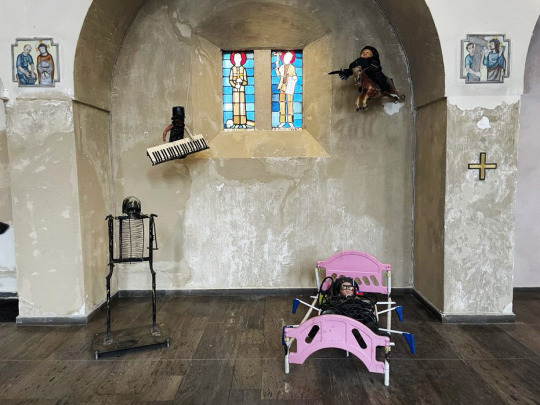
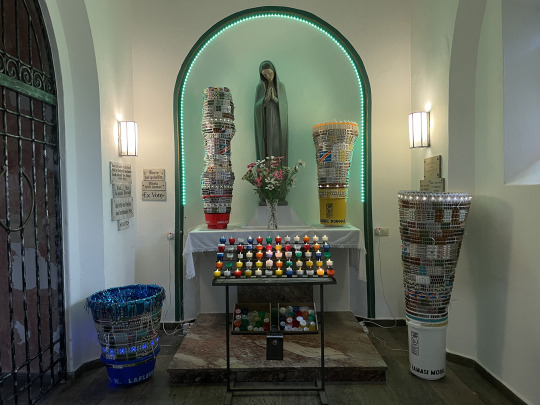
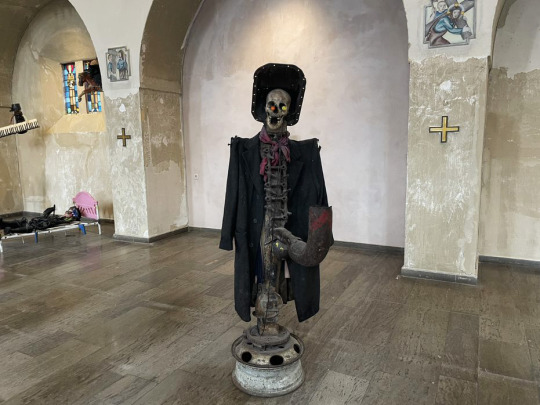
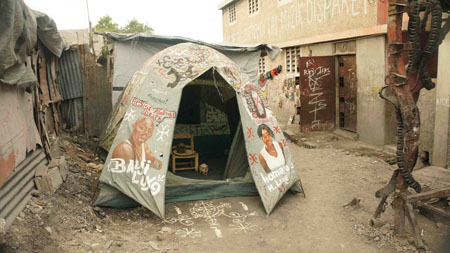

vimeo
Atis Rezistans (Resistance Artists) is a dynamic group of majority-class artists working in the Grand Rue neighborhood of downtown Port-au-Prince, Haiti.
This is a shifting community made up of a number of experienced artists, primarily sculptors, and a range of younger emerging artists, who are working in sculpture and painting, but also, more recently, in photography, video, music, slam poetry, writing, and performance. In December 2009 Atis Rezistans hosted the 1st Ghetto Biennale, which was conceived and devised in 2008 by group member André Eugène and his partner, British artist and curator Leah Gordon. Atis Rezistans invited Haitian and international fine artists, filmmakers, academics, photographers, musicians, architects, and writers, via a global open call, to come to the Grand Rue area of Port-Au-Prince to make work or witness the event in their neighborhood and this event has taken place every two years since then.
...The majority of participating artists in the Ghetto Biennale undertook collaborative and process-based practices. For example, a video and accompanying blog by British artist and writer John Cussans traced his commissioning of a bus painting from Grand Rue sign-painters. But the Ghetto Biennale’s main focus is on art as social practice, providing residents and the local communities with different models of self-representation and self-organization."
On Arab Art Collectives:
Arts in the Americas:
Documenta 15:
Additional sources to look into:
Fucking Good Art -
The Autonomous Fabric of Rotterdam -
Arts Collaboratory -
Raqs media collective:
Werker Collective:
Institute for Queer Ecology
Forensic Architecture
1 note
·
View note
Text
Events 4.4 (before 1950)
503 BC – Roman consul Agrippa Menenius Lanatus celebrates a triumph for a military victory over the Sabines.
190 – Dong Zhuo has his troops evacuate the capital Luoyang and burn it to the ground.
611 – Maya king Uneh Chan of Calakmul sacks rival city-state Palenque in southern Mexico.
801 – King Louis the Pious captures Barcelona from the Moors after a siege of several months.
1268 – A five-year Byzantine–Venetian peace treaty is concluded between Venetian envoys and Emperor Michael VIII Palaiologos.
1423 – Death of the Venetian Doge Tommaso Mocenigo, under whose rule victories were achieved against the Kingdom of Hungary and against the Ottoman Empire at the Battle of Gallipoli (1416).
1581 – Francis Drake is knighted by Queen Elizabeth I for completing a circumnavigation of the world.
1609 – Moriscos are expelled from the Kingdom of Valencia.
1660 – Declaration of Breda by King Charles II of Great Britain promises, among other things, a general pardon to all royalists and opponents of the monarchy for crimes committed during the English Civil War and the Interregnum.
1796 – Georges Cuvier delivers the first paleontological lecture.
1814 – Napoleon abdicates (conditionally) for the first time and names his son Napoleon II as Emperor of the French, followed by unconditional abdication two days later.
1818 – The United States Congress, affirming the Second Continental Congress, adopts the flag of the United States with 13 red and white stripes and one star for each state (20 at that time).
1841 – William Henry Harrison dies of pneumonia, becoming the first President of the United States to die in office, and setting the record for the briefest administration. Vice President John Tyler succeeds Harrison as President.
1860 – The declaration on the introduction of the Finnish markka as an official currency is read in different parts of the Grand Duchy of Finland.
1865 – American Civil War: A day after Union forces capture Richmond, Virginia, U.S. President Abraham Lincoln visits the Confederate capital.
1866 – Alexander II of Russia narrowly escapes an assassination attempt by Dmitry Karakozov in the city of Saint Petersburg.
1887 – Argonia, Kansas elects Susanna M. Salter as the first female mayor in the United States.
1904 – Two Ms ~7.1 earthquakes, among the largest in Europe, strikes Bulgaria, killing over 200 people and causing destruction.
1905 – In India, an earthquake hits the Kangra Valley, killing 20,000, and destroying most buildings in Kangra, McLeod Ganj and Dharamshala.
1913 – First Balkan War: Greek aviator Emmanouil Argyropoulos becomes the first pilot to die in the Hellenic Air Force when his plane crashes.
1925 – The Schutzstaffel (SS) is founded under Adolf Hitler's Nazi Party in Germany.
1933 – U.S. Navy airship USS Akron is wrecked off the New Jersey coast due to severe weather.
1944 – World War II: First bombardment of oil refineries in Bucharest by Anglo-American forces kills 3,000 civilians.
1945 – World War II: United States Army troops liberate Ohrdruf forced labor camp in Germany.
1945 – World War II: United States Army troops capture Kassel.
1945 – World War II: Soviet Red Army troops liberate Hungary from German occupation and occupy the country themselves.
1946 – Greek judge and archeologist Panagiotis Poulitsas is appointed Prime Minister of Greece in the midst of the Greek Civil War.
1949 – Cold War: Twelve nations sign the North Atlantic Treaty creating the North Atlantic Treaty Organization.
0 notes
Text
A Touch from the Abyss
“To forget would not only be dangerous but offensive; to forget the dead would be akin to killing them a second time.”— Elie Wiesel, preface to ‘Night’ (2006)
As if free-falling, the body plunged into darkness. Humid air dampened the skin, cooled the ground, and diffused an earthy scent. The wind’s symphonies sounded celestial from a distance, enchanting the listener into nocturnal woods. This ambience was characterised by “âm”, the form and expression of ‘And They Die a Natural Death’ (2022) by artist and filmmaker Nguyễn Trinh Thi. A homophone in the Vietnamese language, âm has different usages, some of which provide clues to understanding humanist concerns in this work.
In the Vietnamese language, the syllable âm denotes distinct meanings. As a Vietnamese observer, I realised an existing language barrier—artistically and linguistically—that poses a challenge in contextualising ‘And They Die a Natural Death’. By introducing the word âm, I attempt to illuminate foundational layers of Nguyễn Trinh Thi’s presence at documenta fifteen, which is arguably one of the most prominent global exhibitions.
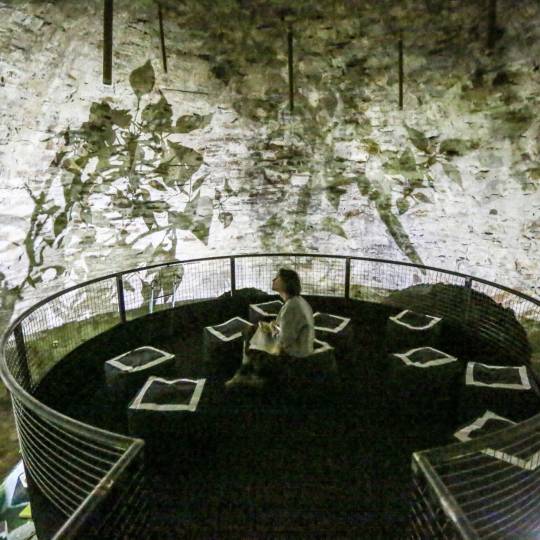
Nguyễn Trinh Thi, ‘And They Die a Natural Death’, 2022, chilli pepper plants, wind, bamboo flutes, projection, monitor. Installation view, Rondell, Kassel. Image courtesy of the artist.

Rondell (circular building on the left), exterior view, Kassel, 2006. Photo by Eva Kröcher. Wikimedia Commons.
Âm 音: sonic, sound
A site-specific art installation, ‘And They Die a Natural Death’ was a public intervention reviving Rondell—Kassel’s long-standing defensive tower built in 1523 and was said to later house torture facilities in its underground vaults. As part of the installation, a high-tech system recreated and implanted the natural environment of Tam Đảo forest in Vietnam. Via this hidden automated design, the Tam Đảo wind was generated in Rondell’s interior, and composed rhythms with the bamboo flutes in the dome. In this absolutely dark cinematic space, sound became the main device to storytelling.
Recently, Nguyễn Trinh Thi began to incorporate new media in her work, including organic materials and natural forces, prioritising the art of listening over mere representation. She experimented with sound as the primary technical apparatus. An ethnographic research trip to the Central Highlands of Vietnam in 2021 touched the artist so significantly that she dedicated her film to the J’rai culture of listening.2 ‘How to Improve the World’ (2021) is the documentary film that acts as a prelude to ‘And They Die a Natural Death’. By appropriating musician John Cage’s diary titled ‘How to Improve the World: You Will Only Make Matters Worse’ (1992), the filmmaker suggests that we should listen to the world around us to survive ecological crises together.3
Âm 荫: tree shade
The Tam Đảo wind not only created sounds inside Rondell, but also activated a lighting system to blow up silhouettes of bird’s eye chilli plants hidden underneath the platform. Enlarged shadows reached the highest parts of the dome, casting a luxuriant forest onto Rondell’s circular wall. Using small plants as main actors, the artist built an eco-theater in which non-human agency played a crucial role in the retelling of death. Chilli pepper shadows inside Rondell formed a panoramic ink painting, and this visual quality could be said to reference East Asian traditional art. In feudal China, the landscape genre seeks to express harmony between Heaven and Earth and cosmic wholeness between humans and nature, and this is observed with the installation.
Nguyễn Trinh Thi’s use of shadow as a visual signifier is not unlike American American artist Kara Walker’s signature strategy, which elicits the legacy of slavery through stereotypical--often grotesque--cut-paper silhouettes. Such technique aids the artists to walk the lines between pleasure and pain, visibility and invisibility, power and oppression.
Preparation of chilli pepper plants before being installed underneath the viewer's platform in the Rondell. Original caption: “She took care of everything - production, plants, people, and text. I’m deeply grateful.” Image courtesy of the artist.
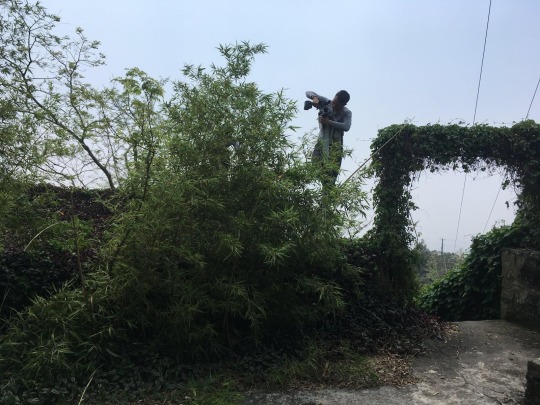
The electrical system which measured the wind’s intensity was being set up in Tam Đảo, Vietnam. Originally captioned “Thank you so much Đức for sending us your wind!!!” Image courtesy of the artist.
Âm 喑: muteness
Like the other projects at documenta fifteen, Nguyễn Trinh Thi’s installation recalled a testimony denied by grand history. ‘And They Die a Natural Death’ was a mute cry for loss and brutality. The artist referenced a chapter in Bùi Ngọc Tấn’s memoir in prison, A Tale For 2000.4 In the labour camp, male prisoners longed for the spicy heat of chilli pepper. One day, the discovery of a vast pepper tree forest caused an uprising in the camp. Unable to control the mob, furious guards fired in the air and ended up shooting a prisoner. The mob went silent and returned to the camp; their hands still held on to the chilli peppers as if it represented fleeting freedom.
As a site-specific project, ‘And They Die a Natural Death’ connected to local history in Kassel. In the Nazi era, the city witnessed book burning, destruction of Jewish synagogue, concentration camps, and Adolf Hitler’s speech in the first Reich Warriors’ Convention. Within this context, the installation can be interpreted as a passive mourning. Its dim lights and eerie sounds gestured towards, in the words of philosopher Jacques Ranciere, “the representation of the inhuman.”5 This rhetorical device employs micro-description of actions, which highlights the absence of humanity experienced in prisoner camps from Bùi Ngọc Tấn’s memoir and Kassel’s Nazi past.
Âm 陰: the underworld
Nguyễn Trinh Thi is neither the first nor the only artist to adapt a ruin’s history in a retelling of memory. However, her philosophy, deeply rooted in Taoism, fostered aesthetic qualities that were peculiar to East Asian and Vietnamese worldviews. In 1987, German artist Rebecca Horn also addressed history by staging a site-specific installation ‘Concert in Reverse’ in a Munster fortification, which was built around the same time as Rondell. While both artists intrigued their audiences with cinematic experiences and sounds from ordinary tools, for Nguyễn Trinh Thi, darkness was crucial to the mise-en-scène of death. Such an artistic strategy inserted the Vietnamese spiritual belief that the dead are not far gone, and that their souls stay in the underworld. With its 10-metre-thick wall, humid air, and absolute absence of light, Rondell became a vessel, displacing viewers to enter a space outside of time. The haunting yet meditative ambience enchanted listeners to feel a tender touch from the abyss.
A story about death is a reminder that nature’s flow waits for no one. However, by narrating death, both storyteller and listener resist this flow and encounter the deceased in a parallel reality. This temporal convergence offers a space for grief, and in some cases, the telling of death helps to make sense of loss.
At documenta fifteen, Nguyễn Trinh Thi presented her ongoing investigation of anti-representation, nonhuman agency, and power. She conceived of “landscapes as quiet witnesses to history.”7 ‘And They Die a Natural Death’ was a live theatre in which nonhuman actors--wind and chilli pepper plants--took centre stage. In this nonverbal retelling of death, artistic strategies were utilised to engage the viewer’s multiple senses. By imagining a gate to the underworld, the artist staged a landscape that connected Kassel and the Tam Đảo forest where the prisoner died a natural death.
1 note
·
View note
Photo

Alexander John - Gewandhaus Session - Neue EP Alexander John aus Kassel hat diese Woche seine neue EP “Gewandhaus Session” veröffentlicht, mit Live-Aufführungen von vier seiner Songs im Gewandhaus zu Leipzig. View this post on Instagram A post shared by ⠀⠀ XAVI (@xavimusik) Der Pianist und Komponist Alexander John steht kurz vor der Veröffentlichung eines seiner eindrucksvollsten Projekte: die Gewandhaus-Session. Dieses außergewöhnliche Projekt […] https://www.musikblog.de/2023/10/alexander-john-gewandhaus-session-neue-ep/ #AlexanderJohn #XAVI #AmbientPop #MusikBlogNewcomer #NewWave #PopKlassik #SingerSongwriter
0 notes
Text
Diversity und New Work in der Verwaltung? Neuer Buchbeitrag von mir.
Mein erstes Buch ist da! Es geht um “Vielfalt in der öffentlichen Verwaltung” und ist just bei Springer Gabler erschienen.
Ich durfte das Kapitel “Diversity und #NewWork schreiben. Für mich natürlich eine Herzensangelegenheit.
Herausgeber Dr. John Meister, einer DER Experten für Transformation in der Verwaltung, lernte ich bereits 2017 auf dem KGSt Forum in Kassel kennen, wo ich einen Vortrag…

View On WordPress
0 notes
Text
Post Producción. Artista: Antoni Muntadas.
BIOGRAFÍA
Desde una perspectiva crítica, su obra aborda temas sociales, políticos y de comunicación de todo el mundo, como la relación entre el espacio público y privado dentro de determinados marcos sociales o los canales de información y la forma en que son utilizados para censurar o promulgar ideas.
Sus proyectos, presentados en distintos medios -fotografía, vídeo, publicaciones, Internet, instalaciones e intervenciones en espacios urbanos-, se han exhibido en el MoMA de Nueva York, el Berkeley Art Museum de California, el Musée Contemporain de Montreal, el Museo Nacional Centro de Arte Reina Sofía de Madrid, el Museo de Arte Moderno de Buenos Aires, el Museu de Arte Moderno de Río de Janeiro, el Musée Jeu de Paume de París[2] y el Museu d’Art Contemporani de Barcelona,en el Centro Cultural de España en Montevideo, entre otros. Además, han participado de certámenes internacionales: en las ediciones VI y X de la Documenta de Kassel (1977, 1997), en la Whitney Biennial of American Art (1991) y en la 51 Bienal de Venecia (1976, 2005), así como en las de São Paulo, Lyon Taipéi, Gwangju, Estambul y La Habana.
Dentro del ámbito académico, Muntadas ha impartido y dirigido seminarios en diversas instituciones de Europa y Estados Unidos, incluyendo la Escuela Nacional de Bellas Artes de París, las Escuelas de Bellas Artes de Burdeos y Grenoble, la Universidad de California en San Diego, el Instituto de Arte de San Francisco, la Cooper Union de Nueva York, la Academia Central de Bellas Artes de Beijing (CAFA), la Universidad de Arte de Tokio, la Universidad de São Paulo y la Universidad de Buenos Aires. Asimismo, ha sido artista residente y profesor de varios centros de investigación y educación, incluyendo el Visual Studies Workshop de Rochester, el Banff Centre de Alberta, Arteleku en San Sebastián, el Studio National des Arts Contemporains Le Fresnoy y la Universidad de Western Sydney. De especial importancia, es la relación que mantuvo con el MIT -Massachusetts Institute of Technology- por más de 35 años (1977-2014), donde ejerció como investigador (research fellow), profesor invitado (lecturer) y profesor (professor of practice) entre 1990 y 2014. Actualmente es profesor del Instituto Universitario de Arquitectura del Véneto de Venecia.
Muntadas ha recibido diversos premios y becas por parte de instituciones como la John Simon Guggenheim Memorial Foundation, la Rockefeller Foundation, el National Endowment for the Arts, el New York State Council on the Arts, Ars Electronica en Linz, Laser d’Or en Locarno, el Premi Nacional d’Arts Plàstiques concedido por la Generalitat de Catalunya y el Premio Nacional de Artes Plásticas 2005. Una de sus distinciones más recientes es el Premio Velázquez de Artes Plásticas 2009,[3] otorgado por el Ministerio de Cultura español.
MI OBRA
"FAKE NEWS"
Este término es utilizado para conceptualizar la divulgación de noticias falsas que provocan un peligroso círculo de desinformación.
Partiendo de esta definición, como primer instancia, realicé una instalación de noticias de este tipo, convenciones sociales y divulgación de noticias de origen fraudulento.
La selección la centré en la búsqueda en Internet, de frases que se asocien a personalidades históricas (científicos, artistas,etc.), a falsas creencias y cadenas de WhatsApp, en donde se pretendía era captar información privada o concretar una estafa.
La instalación se llevó a cabo en una habitación cerrada, con impresiones de "FAKE NEWS" colgadas desde el techo en forma circular y en el centro un conjunto de ellas más juntas y otras en el piso.
El objetivo central de la obra es poder visualizar, leer, recorrer la instalación, tocar si es necesario, buscar el sentido de la hoja que cuelga, invitando al espectador a ser parte y reflexionar lo que está observando.
La idea principal es reflexionar si creemos todo lo que vemos y leemos, si se dimensiona la intencionalidad detrás de una Fake News, o de una convención, tal vez pasada de generación a generación, o si puede tal vez, ser con un fin delictivo.
Lo interesante de relacionar mi obra con Antoni Muntadas, es la idea de replantear el uso de la información.
En mi caso, exponer en esta oportunidad, la No Información, y hasta que punto lo que se nos dice o se nos presenta es creíble. Si somos capaces de cuestionar o buscar fuentes que afirmen o no esas noticias, creencias, etc. O simplemente nos conformamos, o damos por echo o como verdadero, algo que se difunde en los medios por estar ahí.
0 notes
Text

#MarkerMonday
Hopper House
Birthplace and boyhood home of the eminent realist painter Edward Hopper (1882-1967). The Hoppers’ forebears came from Holland in 1652, and the artist’s grandfather built this house in 1858. After graduating from Nyack High School, Hopper moved to New York but returned to the family home throughout his life. Local citizens saved the house in 1970 and formed the Edward Hopper Landmark Preservation Foundation. Hopper lies buried in Oak Hill Cemetery.
Nyack Rotary Club
Marker is at 82 North Broadway, Nyack NY 10960
Upon the occasion of Hopper’s 100th Birthday, the Historical Society of Rockland County mounted an exhibition honoring the great American artist. The following essay appeared in a special edition of the HSRC’s history quarterly “South of the Mountains.”
EDWARD HOPPER: HIS ROCKLAND HERITAGE AND LEGACY
by Arthayer R. Sanborn
South of the Mountains Special Exhibit Edition
Vol. 26 Special Exhibit Edition Summer 1982
Edward Hopper was born 100 years ago, on July 22, in the small white house that still bears his name on Nyack’s North Broadway. The house, in which he spent his boyhood, was built by his maternal grandparents, John DeWint Smith and Elizabeth Griffiths Smith. When in 1879 their daughter, Elizabeth, married Garret Hopper, the young couple took over and for more than a century, their home has been the Hopper house.
In the early 1970's, the house narrowly escaped extinction. After the last Hopper had died, it became a dilapidated, boarded-up relic, still filled with Hopper memorabilia but an almost certain candidate for demolition. Then a small, determined local group, aware of Hopper’s worldwide fame and of the local and historic influences which had helped to shape it, went into action. Spearheaded by Jeffrey Arnold, the group included Winston Perry Jr., Robert Kassel, Stephen Leeman, Sterling Norris, William and Dorothea Hope, John Cant, Ruth Diebold, Alan Gussow, Susan Reed, John Moment, and Robert Miniciello. They raised the funds to stave off demolition. They did the hard, grueling hands-and-knees work necessary to restore and preserve the house.
By May 1971 they had established the Hopper Landmark Preservation Foundation which the following month was incorporated under the New York State Board of Regents. Soon programs and exhibitions, featuring local artists present and past, brought visitors from all over the metropolitan region to the house —tens of thousands in the last decade.
Hopper House is not only a loving memorial to a great artist, but a vibrant symbol of local recognition and commitment to preservation of cultural values.
John DeWint Smith, Edward Hopper’s maternal grandfather, may be called the founder of Hopper House. He selected the site and built the house in 1858. The plot, part of the land of Simon Sickels, was owned at the time by Richard Decantillon and Richard R. Eells. The land cost $1100 and the house $1593.
Mr. Smith came from the family who had owned the DeWint House in Tappan. Johannes DeWint, born April 12, 1716, on the Danish Island of St. Thomas, was a wealthy sugar plantation owner. At the age of 30, he bought the DeClark House, built in 1700 by Daniel DeClark, one of the original Tappan patentees. This house, the oldest in Rockland County, sometimes served as headquarters for General Washington. It is a historic landmark, but it had been owned through the years by some of Hopper's relatives. The last of the family to occupy it was Thomas Blanch Smith, John DeWint Smith's son by his first wife, Eleanor Cornelison Blauvelt. [Read More here: https://nyheritage.contentdm.oclc.org/digital/collection/hsrc/id/2460/rec/1]
There is a new exhibition at the Hopper House on view now celebrating Hopper’s early years in Nyack. Learn more here: https://www.edwardhopperhouse.org/hopper-boyhood.html
There is a special screening of a new documentary on Hopper at Rivertown Film on 11/16. Learn more here: https://rivertownfilm.org/hopper/
#rockland history#local history#rocklandhistory#rockland county#nyshistory#nys history#orangetown#nyack#historic preservation#edward hopper#american art#art history
1 note
·
View note